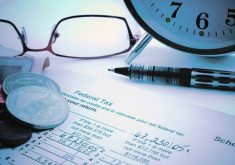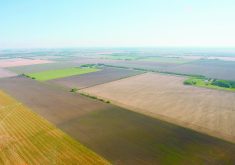Most farms are taxed on a cash basis and there are many taxable income management tools available to farm operations that other industries envy. These tools help manage uncertain earnings fluctuations that producers experience while allowing producers to access the beneficial tax brackets and rates.
The farming lifecycle usually begins with proprietorships and as profits increase there is a shift toward the different deferral tools, which ultimately include incorporation. The large snowball as a proprietor can have devastating tax implication upon death.
Many producers recognize the upside of the tax deferral tools that are available to them, but significant tax costs can be incurred in the future if they are mismanaged.
Read Also

Downturn in grain farm economics threatens to be long term
We might look back at this fall as the turning point in grain farm economics — the point where making money became really difficult.
Deferring income — Grain sales and crop insurance can be deferred when the elevator issues a postdated cheque for the following tax year. Cattle sales cannot be deferred other than the livestock tax deferral provision for prescribed drought and flood regions.
The downside: Income deferred this year is taxable income next year. Farm operations often get caught deferring more and more earlier each year to avoid a tax bill.
Deferred income has a hidden cost in the time value of money, especially with rising interest rates. Grain companies are happy to keep your money without paying interest. It may make more sense not to defer and use the cash to pay down debt or invest instead. For example, a Saskatchewan corporation with income of less than $500,000 could cash the grain, pay tax at the temporarily low corporate rate of nine percent and then use this cash to pay off input loans at nine percent, plus interest rates.
Prebuying expenses — Due to cash basis taxation, producers can generate expenses by prebuying next year’s inputs such as fertilizer, seed and fuel.
The downside: The deduction this year means no deduction next year. This can grow to larger amounts that become unmanageable. Often smaller prebuys tend to be good business decisions, such as taking advantage of an early payment discounts on canola seed. Be careful of just spending money to create deductions. The decision needs to make economic sense.
Buying equipment — With the new immediate expensing rules for equipment, equipment purchases can generate large tax deductions. Our firm’s Nov. 17 article about how immediate expensing can help create huge tax deductions has more details.
The downside: Expensing equipment now will lead to taxable income (recaptured depreciation) in the future when selling equipment. If the equipment is fully expensed, funding equipment loan payments in the future will require cash basis taxable income without any offsetting depreciation deduction.
Incorporating — When farming operations grow profitably, they either incorporate or are faced with personal tax bills approaching 50 percent. The small business deduction for the first $500,000 of taxable income is temporarily nine percent in Saskatchewan, nine percent in Manitoba and 11 percent in Alberta.
There are two ways to incorporate, either rolling farming assets into a corporation on a tax deferred basis or selling farm partnership interests to a corporation. The best tax planning is to sell farm partnership interests to a corporation using the tax-free capital gains exemption. However, this requires planning because the partnership must operate for at least two years before the sale to the corporation.
The downside: Deferred grain cannot be rolled to a corporation so the timing of the incorporation will need to be planned around this. Incorporating involves reconciling a separate set of books and professional fees. Typically, the tax savings from incorporating are much better than a 47.5 percent personal tax bill.
RRSP contributions — RRSPs are the only deduction available for personal tax planning after Dec. 31. RRSP contributions that are made by March 1, 2023, are deductible against 2022 personal income. Dividends from a corporation do not generate RRSP room, only earned income generates contribution room.
The downside: RRSPs are taxable income when withdrawn. This makes it difficult to reinvest the funds in the farming operation. RRSPs are typically invested for the long term for retirement. It’s best to contribute to RRSPs when you are in higher tax brackets, and then withdraw them in lower tax brackets in retirement.
Paying some tax — Farmers usually want the lowest taxable income possible. Why not use the lowest tax brackets instead? Personally, the lowest tax bracket is almost $50,000 of taxable income, and the second tax bracket is almost $100,000. Farm operations often snowball by delaying paying tax for years, only to have a lot of taxable income at high tax rates. Deferring $50,000 a year rather than paying tax for 10 years suddenly becomes $500,000 of taxable income.
The downside: Sending money to the government.
Deferring paying tax now at lower rates may mean paying tax at 47.5 percent personally (the top personal tax bracket in Saskatchewan), or 27 percent in a corporation (23 percent in Alberta) in the future.
If you are increasing your taxes owed with larger deferrals each year, it’s important to get advice from an accountant with farm tax experience to plan for the future.
Levi Derksen, CPA, CGA, is a senior manager in the ag team at Buckberger Baerg & Partners LLP in Saskatoon. He can be contacted at lderksen@bbllp.ca.

















